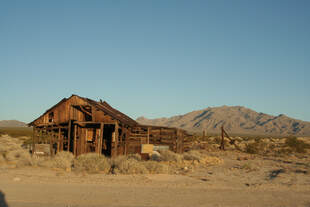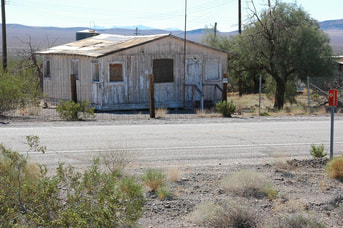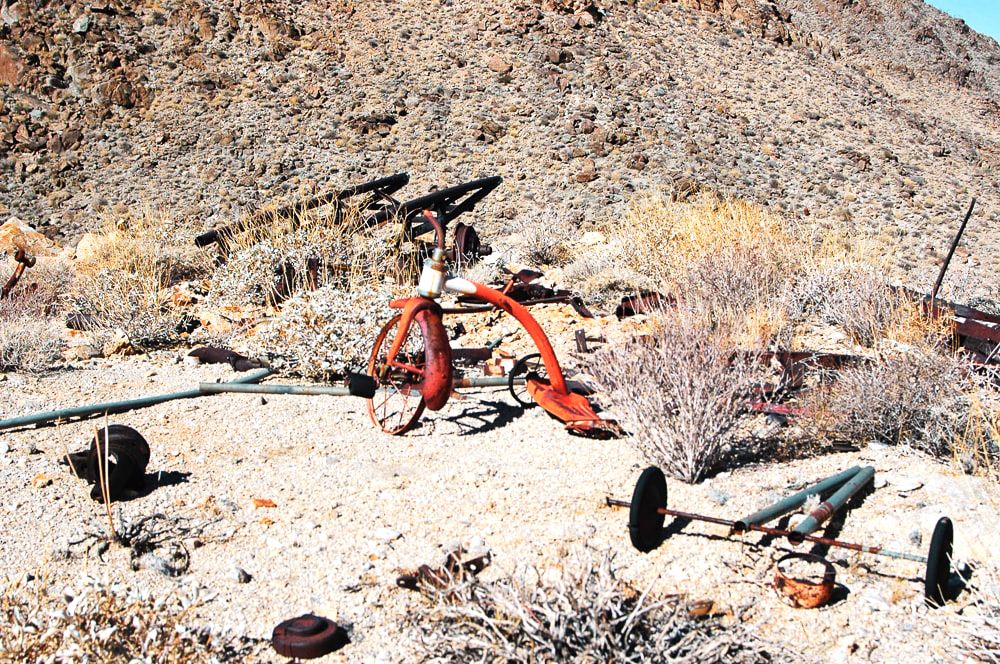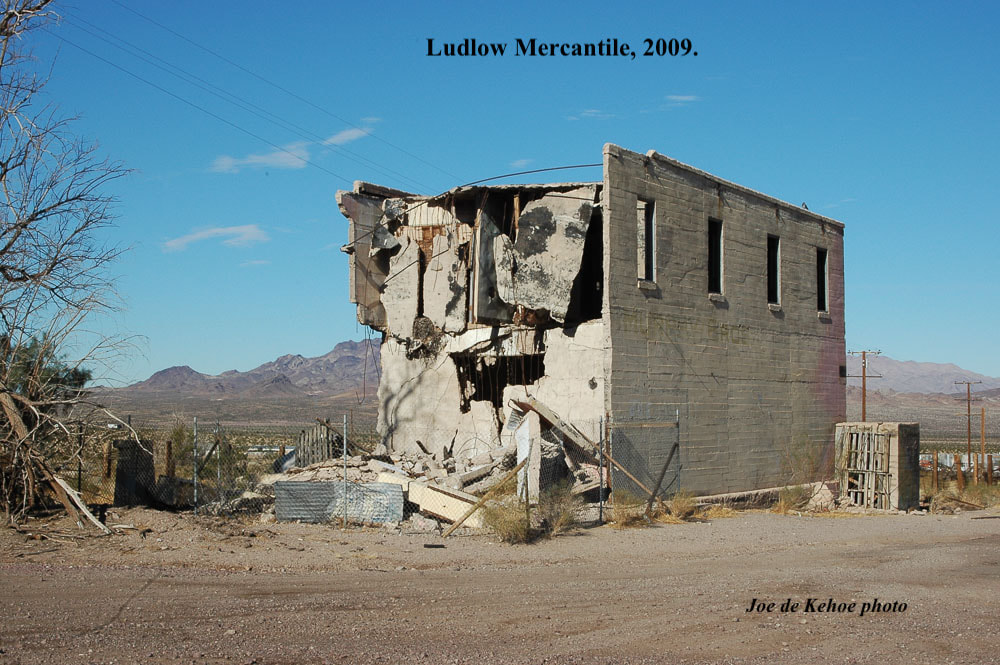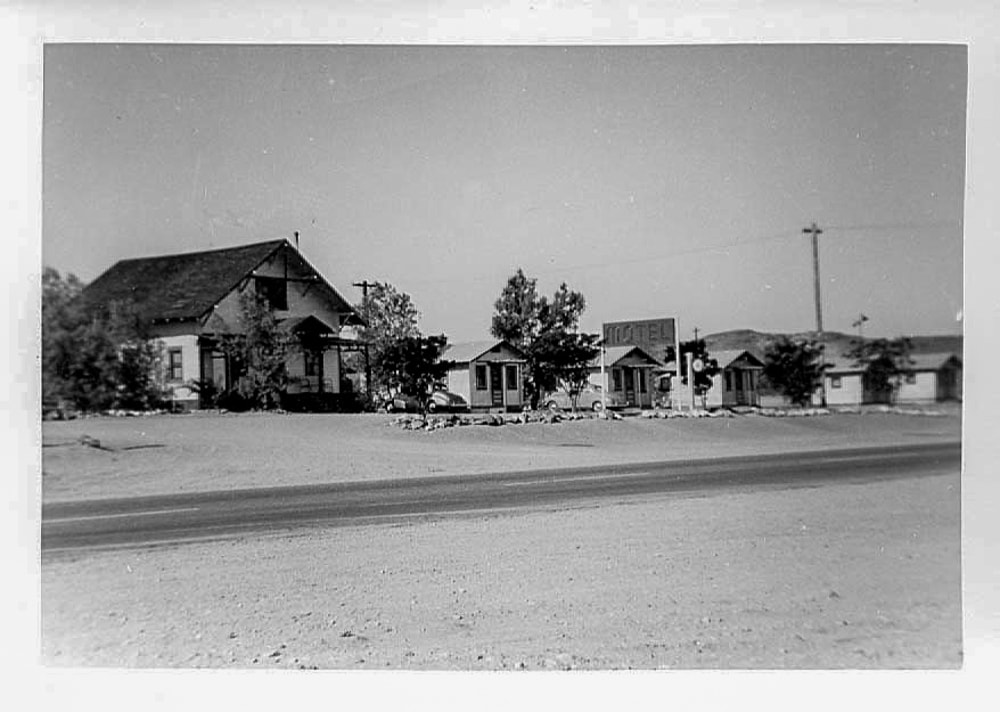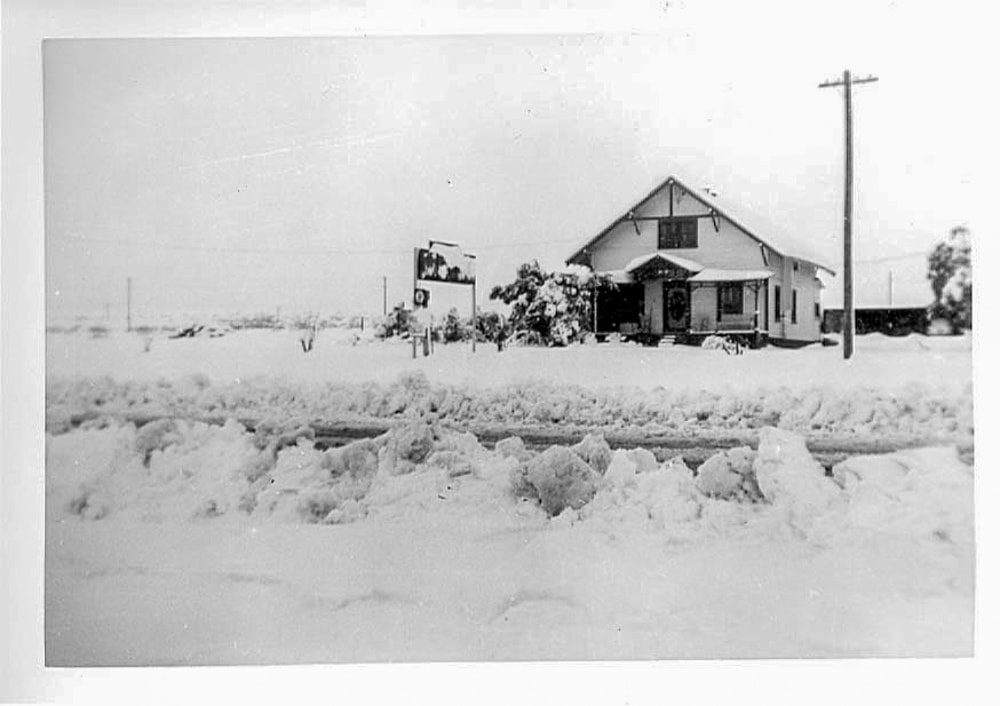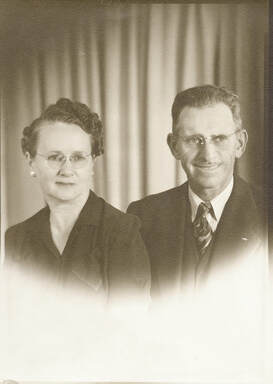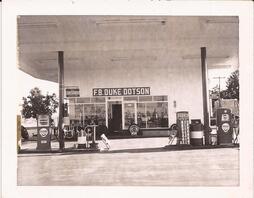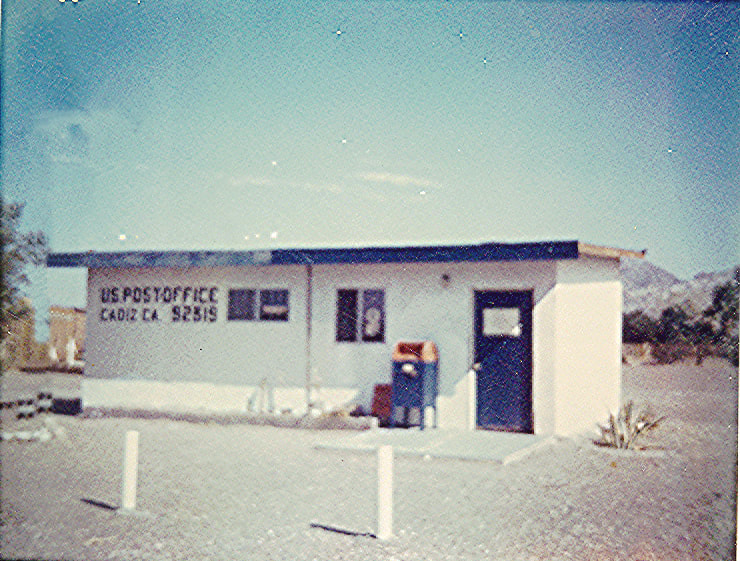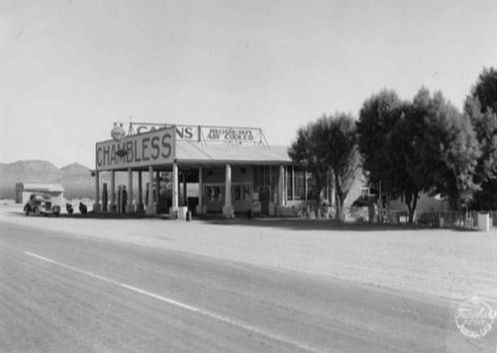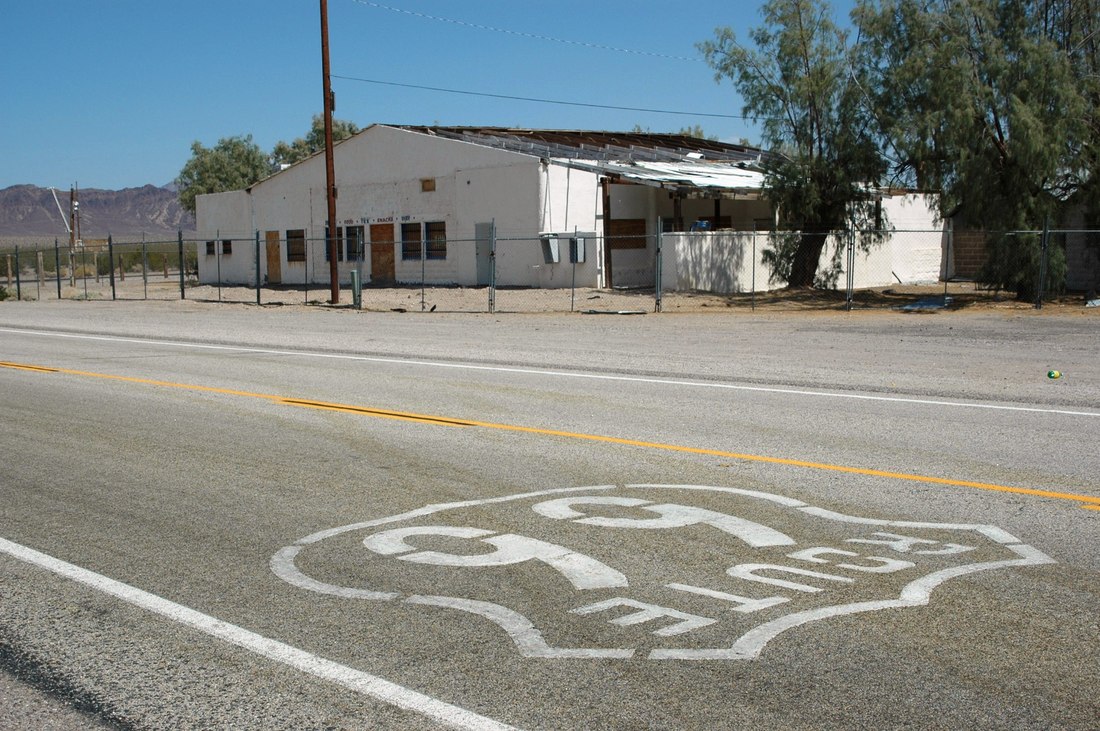|
As you approach Essex on National Trails Highway the highway sign reads "population 100". Even during its busiest period in the 1960s and 1970s the permanent population of Essex probably never exceeded 35 people. The current population of Essex is 5. The one-hundred population figure was put there by the highway department and was based on the number of letter boxes in the post office.
As is the case with most of the former businesses on Old Route 66 through the Mojave Desert of California, today the small cluster of buildings that comprise Danby is just a remnant of what it once was. The site that exists today originated in the early 1930s when Old National Trails Road, Route 66, was paved. Located on the road between Essex and Chambless, during the busiest period in the early 1970s Danby consisted of a garage, a service station, two or three wood framed houses and trailers, and several out-buildings, one of which served as a court house for the Justice of the Peace. There were three places in this immediate area of the desert referred to as Danby. The first one was established in 1883 by the Southern Pacific Railway as a watering stop for the steam locomotives, about 2 miles southeast of what is today National Trails Highway. The name Danby followed the railroad’s convention of naming stops in alphabetical order going east from Amboy – Bolo, Cadiz, Danby, Essex, etc. Initially, water was piped to the railroad via a 2-inch steel pipe from Bonanza Spring in the Clipper Mountains 5 miles northwest of the tracks. As railroad traffic increased the railroad eventually drilled several good water wells at Danby and build a large pumping station. Danby became an important watering stop for the railroad and was home to both railroad workers and a few prospectors who worked mines in the Old Woman Mountains. The concrete pad marking the location of the water wells can still be seen just a few feet south of the tracks, but there is no trace left of the pumping station. Former pumping station at Old Danby, circa 1932.One of the miners living at Danby, Walt Zindell built his cabin out of sheets of corrugated tin but chose to live in a yellow school bus that he parked at the side of the cabin. Although badly dilapidated, Zindell’s cabin and bits and pieces of the school bus are still there. Another miner / prospector, Ben Benjamin built a wooden cabin at Danby that finally succumbed to the elements and collapsed in 2004. While the railroad stop was in operation, Johnny Neilson moved to the Mojave Desert from Scotland and built a service station at the intersection of Old National Trails Road and the primitive dirt road that followed the railroad’s water pipeline north to Bonanza Spring. ( 34° 38’ 26.31” N. 115° 21’ 18.30” W.). The site was about three-quarters of a mile northeast of the railroad. Johnny called it the Bonanza Spring Service Station, but area residents called it simply “Danby Station”. Unlike most service stations along the highway in the desert, Johnny advertised free water to travelers. At the time National Old Trails Road was a dirt track that went in a nearly straight path from Essex to Cadiz. Although it is nearly grown over, traces of the old road are still faintly visible today.  In 1931 the Highway Department paved what was then designated Route 66 between Needles and Barstow but shortened and straightened the road wherever possible. Consequently, the newly paved highway was relocated to its present position, about a mile and a half north of the railroad tracks and a mile north of Johnny Neilson’s “Danby Station”. Neilson moved his service station north to the new highway and was eventually joined by his brother Bill, also from Scotland. Johnny was later elected Justice of the Peace and built a small building at Danby to serve as his courthouse. Although badly weathered, the building is still there. Sometime later a garage was also built at Danby to service travelers on the highway, and it went through several owners during the time it was in operation. The garage, with the mural of a mountain man scene on the front door facing the highway is also still there but is in bad shape and likely to collapse in a few years. Neilson’s gas station in Danby was leased to Slim Hartzler from 1955 to 1960. Neilson did not renew Hartzler’s lease when it came due because he wanted to rent the station to his secretary and her husband. The Hartzler’s left and a few days later the station burned to the ground and was never rebuilt. No trace of the service station remains today. Anyone wishing to view Danby, please do so from the highway as it is all fenced private property and home to a family living there who would prefer not to be disturbed.
From about 1965 to 1967 two prospectors named Jerry Caywood and Jim Craig operated a gold mining operation in Rattlesnake Canyon on the north flank of the Old Woman Mountains, about 7 miles southwest of Danby on old Route 66 in the Mojave Desert of California. Although they were able to extract some placer gold from the dry wash, the amount of gravel that had to be sorted and washed was too labor intensive and expensive to make the operation profitable and consequently the mine was abandoned. As far as I know, the mine never had a name.
On July 30, 2020 firefighters from San Bernardino County Fire Department responded to vehicles and a structure on fire on National Trail Highway in Ludlow, California. Crews from Southern California Edison also responded to the incident as power lines were also down. In addition to the building the fire had also extended to an adjacent pile of old tires. Crews working on the fire were hampered by the lack of water supply but were able to extinguish the blaze utilizing water tenders and a water shuttle operation. The cause of the fire is not yet known. The burned building was formerly a Mobil service station in Ludlow that was run by the previous owners, Cameron and Laurel Friend. It had originally been located about 1/8 mile east, but was moved to its present location adjacent to the Ludlow Cafe. *** Source: San Bernardino Fire Department
On July 30, 2020 the iconic Roadrunner's Retreat on old Route 66 near Chambless, California was burned in a fire.
County Fire Battalion Chief Donnie Viloria said workers who had just finished their shift in Cadiz noticed the fire at the Roadrunner's Retreat, but because they didn’t have cell reception, they had to go somewhere else to report the blaze. Viloria said the Roadrunner Retreat is in such a remote area on Route 66 that the fire had been burning for hours before anyone noticed and it took the firefighters more than an hour to reach the fire. He added that while the diner building is still standing, all the contents inside were destroyed. The adjacent Roadrunner gas station was not affected by the fire. The cause of the fire is suspicious in nature. On July 30, 2020 the Roadrunner' Retreat, an iconic former cafe on old Route 66 near Chambless, California was burned in a fire. County Fire Battalion Chief Donnie Viloria said workers who had just finished their shift in Cadiz noticed the fire at the Roadrunner's Retreat, but because they didn’t have cell phone reception, they had to go somewhere else to report the fire. Viloria said the Roadrunner's Retreat is in such a remote area on old Route 66 that the fire had been burning for hours before anyone noticed and it took firefighters more than an hour to reach the fire. He added that while the diner building is still standing, all the contents inside were destroyed. The adjacent Roadrunner gas station was not affected by the fire. The owner of the Roadrunner Retreat was notified of the fire by fans of a Route 66 social media page. The cause of the fire is suspicious in nature. 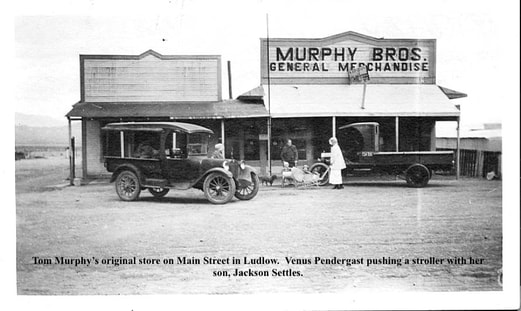 The Ludlow Mercantile store on Main Street in Ludlow dates from the about 1907. it was originally built by John Denair, who was in the process of moving his businesses from Bagdad to Ludlow and it was Mr. Denair who built the 2-story reinforced concrete building on the corner of Main and Cone streets in Ludlow in 1908 and opened the business as the Ludlow Mercantile Company. John Denair was originally a conductor and later a superintendent for the Santa Fe Railroad and was a prominent businessman in the area. He held large parcels of land and a mercantile store at Bagdad, California and in Stanislaus County. In Bagdad he owned the Denair Mill site, he had offices for managing the Orange Blossom Mine where he was part owner, and he owned the building that housed the Bagdad Post office. Apparently Mr. Denair's Mercantile store in Ludlow was financed wholly or in part by a local business woman in Ludlow, "Ma" Preston. Matilda (Vigneron) “Ma” Preston had arrived in Ludlow with her husband Tom about 1902 and she owned several businesses in Calico and Daggett as well as a saloon, a restaurant and a boarding house in Ludlow. "Ma" Preston was Ludlow's legendary "Queen of the Desert" and no serious history of Ludlow is complete without including her. Oddly, Denair purportedly defaulted on payments and turned the Mercantile Company business over to "Ma" Preston. However, she always cussed that concrete store because Denair’s name was once imbedded in the concrete at the peak on top but she eventually had it removed. In 1920 Ma persuaded her husband Tom to retire and move back to her native France. She sold the store to Tom Murphy who operated the establishment as Murphy Brothers Ludlow Mercantile. Prior to purchasing the business from Ma Preston, Tom Murphy ran a competing general store that was originally in a tent and then later as a wood frame building on Ludlow’s Main Street immediately west of Ma Preston's 2-story concrete building. Farther east on Main Street he owned a garage / service station, the Shamrock Hotel and Cafe, and a saloon. He is also credited with building the Catholic Church in Ludlow which later burned down. During the time that both Ma Preston and Tom Murphy were operating businesses in Ludlow they were fierce competitors and bitter enemies. However, when Ma sold the store to Murphy before moving back to France they hugged each other goodbye. Ma Preston and Tom both died in Marne, France in 1926. When Murphy moved his business into the 2-story concrete building he continued to use the ground floor for general merchandise and the second story continued to be used as a hotel. “Murphy Bros. General Store” was painted in large letters on the east side of the building to attract the attention of motorists on Ludlow’s main street, but today the inscription is faded and barely legible. In 1931 the store was completely gutted in a fire, but the walls held and the interior was rebuilt shortly thereafter. Tom Murphy's Chevron station and Shamrock Cafe facing Route 66 in Ludlow, California. This photograph shows three Ludlow girls in the newest style of overalls from Murphy’s store. Tom Murphy had ordered a supply of the overalls in hopes they would become popular items and he was smart enough to sell them first, and sell them cheap, to girls who were daughters of the town’s prominent citizens. If anyone didn’t approve of the girls’ outfits, they had to say so behind closed doors so the fathers wouldn’t catch wind of such remarks. The outfits were really quite daring for young ladies at that time but soon caught on and became a popular item in Murphy’s store. Venus McNeill is on the far left. The other two girls are not identified. Route 66 through Ludlow was paved in 1931 but the new highway was relocated about one-half mile north of the original road and consequently Main Street was no longer on the main highway and businesses that catered to motorists began to decline. The Ludlow Mercantile, the Ludlow Motel, the Pendergast residence and the original Ludlow school are the only old Ludlow buildings that still remain – all of the former businesses on Main Street have been demolished. Murphy’s store has been completely abandoned for several decades and was badly damaged by two earthquakes, one in 1999 and one in 2008. My thanks to J'lene, Venus Pendergast's granddaughter and Martha Burnau for historic photos of Ludlow and original copies of the letters of Venus Pendergast from which this information was taken. Info on Ma Preston courtesy of Delmer Ross.
The Ludlow Motel (below) circa 1940.  Venus McNeill Pendergast and her husband Henry “Penny” moved to Ludlow from Escondido in 1939. Venus had lived in Ludlow previously with her family because her father, Thomas McNeill worked as Roadmaster for the Santa Fe Railroad. She attended beauty school in Escondido but suffered from hay fever and soon after they were married she persuaded Penny to move back to the desert. When they arrived in Ludlow they initially stayed with their friends, Jack and Vernie Sherraden. Vernie was the Ludlow Postmaster. The Sherradens suggested that they buy an old run-down hotel that was for sale at that time. The hotel was originally the Mohawk Hotel in Goldfield, Nevada. In 1921 the building and the adjacent cabins had been moved to Main Street in Ludlow and operated as the Oasis Hotel. The Pendergasts bought it and moved it about two blocks north, facing old Route 66 and operated it as the Ludlow Motel. The motel consisted of a main building with 6 or 8 separate small cabins all facing old Route 66 on the east end of Ludlow. Venus and Penny lived in a small wood frame house across the street. Penny was elected Constable of that portion of San Bernardino County and so he had his law enforcement duties as well as the hotel business. Venus served as Penny’s deputy whenever a matron was needed for for women prisoners. The hotel building is still there, but it badly dilapidated. One of the cabins is also still there as is the small wood frame house across the road where Venus and Penny lived. The Ludlow Motel in 2007. Joe de Kehoe photo. Ludlow Motel in 1940 with the adjacent cabins, only one of which is still there. The Ludlow Motel after a rare snowstorm. Year??? Venus and Henry "Penny" Pendergast. Penny remained in the job as Constable until he retired in April 1967. He died two months later on June 12th.
When Penny died Venus moved back to Escondido to be near her son Jackson and she died in 1989. Venus and Penny are buried together in Barstow, California. 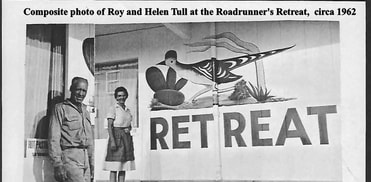 The Roadrunner’s Retreat is a mile and a half west of Chambless and 10 miles east of Amboy, California on National Trails Highway, formerly Route 66. The business consisted of a restaurant and service station that was started by Roy and Helen Tull in the early 1960s.  Roy Tull was a truck driver and envisioned the Roadrunner's Retreat as a truck stop strategically positioned on Route 66 between Needles and Barstow. While construction was still underway Roy sold the 40-acre property to F. B. “Duke” Dotson who formerly owned and operated Duke’s Western Wear in Montclair, California. Roy and his wife Helen may have operated the café for a couple of months, but soon after it opened in 1962 Dotson took over and ran the service station and restaurant as a truck stop and towing service. In 1963 the rest of Dotson’s family, his wife Virginia, and their two sons and daughter moved out to the desert and settled into a mobile home parked behind the restaurant. Duke Jr. recalls that when he arrived, fresh out of the 6th grade, his dad told him to put on an apron and start bussing tables. He said that he thought his life had come to an end moving from Ontario out to this place in the desert. Roy Tull’s wife Helen worked in the restaurant for a short time with the help of several local women who served as waitresses, one of whom was Lola Joyce Nelson, a Navajo Indian who lived nearby at the railroad depot at Cadiz. It was not uncommon at the time on Route 66 for a man and wife team to arrive looking for work. If there were openings Dotson would hire the husband to work either in the restaurant as a cook or at the service station and the wife worked as a waitress. The Standard Oil service station just east of the cafe was built with a distinctive Googie-inspired upswept roof, an architectural style that was popularized in the 1950s and 60s, influenced by the up and coming Space Age, the Atomic Age and Jets. In addition to the service station / garage, Dotson also ran a towing service with the help of a Texan named John Gwen. Together, John and Duke, and of course their German Shephard “Ace”, built and maintained all of the trucks and “fixed everything that was broken”. Duke’s first tow truck was named “King of the Road”, but all of the other trucks were named after bears: “Smokey”, “Papa Bear”, “Mama Bear”, “Teddy Bear”, and “Grizzly Bear”. Today both the cafe and service station are boarded up and slowly deteriorating. While The Roadrunner’s Retreat was open a small community of a dozen or so mobile homes grew up behind the diner and provided living quarters for some of the employees who worked in the restaurant and the service station, but all of those have now either been removed or are also in ruins.
The Roadrunner closed in 1973 when Interstate 40 was opened between Needles and Barstow and this section of the highway was bypassed. All of the roadside businesses on this stretch of Route 66 through the Mojave Desert between Essex and Ludlow died almost overnight. Businesses that depended on tourist and commercial traffic – service stations, restaurants, motels, car repair shops – were all forced to close. Duke Jr. remembers that when his father made the decision to close they were in the restaurant for most of the day and their only customer was a railroad employee who stopped in for a cup of coffee and not a single car went by on the highway. After the Roadrunner’s Retreat closed Dotson sold the property to the Murphy family who are still the current owners. Mr. Murphy never intended to reopen the restaurant; his interest was more toward having a desert retreat and in maintaining the site for its historic significance on old Route 66. Before he passed away Mr. Murphy was able to enjoy memorable weekends on the property with his family. The distinctive neon sign next to the highway that advertised the Roadrunner’s Retreat, although weather-beaten and pale, still stands and is immediately recognizable as one of those iconic symbols on this stretch of old Route 66 and there are tentative plans in place to re-light the sign although the service station and restaurant will remain closed. Lat 34° 33.6643’ N. Long 115° 32.6631’ W.  Chambless is known by several names – Chambless, Chambless Junction and Cadiz Junction, but to local residents it is just “Cadiz”. Today the small settlement of Chambless stands on National Trails Highway and bears little resemblance to the busy intersection it once was. The most prominent landmark is an abandoned service station and general store surrounded by a chain link fence and with boarded up motel cabins in the rear. There are some homes in the area, only a few of which have permanent residents.  Jim and Fannie Chambless circa 1926 at their original home and Red Crown service station on what was then designated National Old Trails Road. Jim and Fannie Chambless circa 1926 at their original home and Red Crown service station on what was then designated National Old Trails Road. The place was named after James and Fannie Chambless who operated a service station and general store on Route 66 when the highway was a dirt road and was about a half mile north of the current paved highway. Jim and Fannie lived there with their two children, Melvin and Pearl, and Jim’s mother, Ellen. Jim [James Albert] Chambless was a native of Portales, New Mexico, and came to California in the early 1900s. He built a service station on the dirt road that was then called National Old Trails Road, later renamed as Route 66. When Route 66 was paved and realigned to where it is now, Jim and Fannie’s service station was left stranded on the old road about a half mile north of the new highway so, in the 1930s, they moved their store to the new location on the main highway. The new store cost about $7,000 to build and was run by Jim and Fannie with help from one of Fannie’s friends, Mrs. McRae, from Long Beach. There was no electricity at the time, so they had a small generator on the back porch that ran off a Chevrolet engine. Chambless was not connected to the rural electric grid until 1964. For water, Jim drilled a well on the property using piping and machinery from the Orange Blossom Mine north of Bagdad, which was in bankruptcy at the time and was in the process of being abandoned. So why is it referred to as Cadiz?  Chambless service station after being rebuilt on Old National Trails Road. Circa 1930. Chambless service station after being rebuilt on Old National Trails Road. Circa 1930. In years past the BNSF railroad depot at Cadiz, 3 miles south of Chambless, also housed the Cadiz post office. In 1967 the railroad decided to close the depot so the post office was forced to find a new location. The Cadiz postmaster at the time was Andrea Limon. By this time, passenger traffic on the railroad had dwindled to practically nothing so there was no compelling reason to keep the post office near the railroad. Therefore, for the convenience of mail deliveries Andrea moved the post office into a small trailer up on the highway across the road from the Chambless General Store. However, shortly thereafter the postal service required a more permanent building so in 1972 Andrea built a small stucco building on the property and that became the post office.
Jim Chambless died in 1940 (1879 – 1940) and his son, Melvin, took over the job of running the store and the service station. About 1944, Melvin sold the store to William and Willa Riddle who, with their son Jack, ran it as a Shell station and later as a Richfield station. Jack Riddle retired to Hemet in 1964 and sold the property to Steve and Lorraine Stephens who operated the store until they retired to Twentynine Palms in 1991. In spite of the market changing hands several times, the intersection retained the name of the original owners and is still shown on maps as Chambless or Chambless Junction. Fannie Chambless retired to Barstow when her husband died, and she passed away in 1966. Jim, Fannie, and Ellen Chambless, James’s mother, are all buried in Mountain View Cemetery in Barstow. The store was expanded over the years to include several improvements and somewhere along the lines the owners added motel cabins on the south and east side of the store. Most of the cabins behind the store are gone, but the ones to the east were more robust and are still there but are completely abandoned. The service station changed hands and brands many times over the years. Originally Jim operated as a Red Crown gas station, but in later years the station was operated by Mobil Oil, Shell, and Arco. The awning over the gas pumps was torn off during a freak tornado that rushed through the area and was never rebuilt. Even after Interstate-40 was opened in the early 1970s the Chambless store and gas station remained open because people in The San Diego and Palm Springs area of California realized that they could get to the casinos in Laughlin easier by going through Twentynine Palms and Amboy, and via Chambless, than by using I-15 and I-40. That continued for a few years, but eventually the Chambless store suffered the fate of all of the other businesses along old Route 66 that depended on highway travelers and was forced to close as traffic dwindled. The market is now an abandoned building surrounded by a chain link fence. About 2008, a large piece of the tin roof was blown off in a wind storm, and although there is occasional mention of the store being reopened, the building becomes more dilapidated each year. Most of the motel rooms that were behind the market have been torn down and the desert is trying its best to reclaim the land.
|
OverviewRead more about Joe's photos, book excerpts, articles, updates, & more! Archives
October 2023
Categories
All
|




